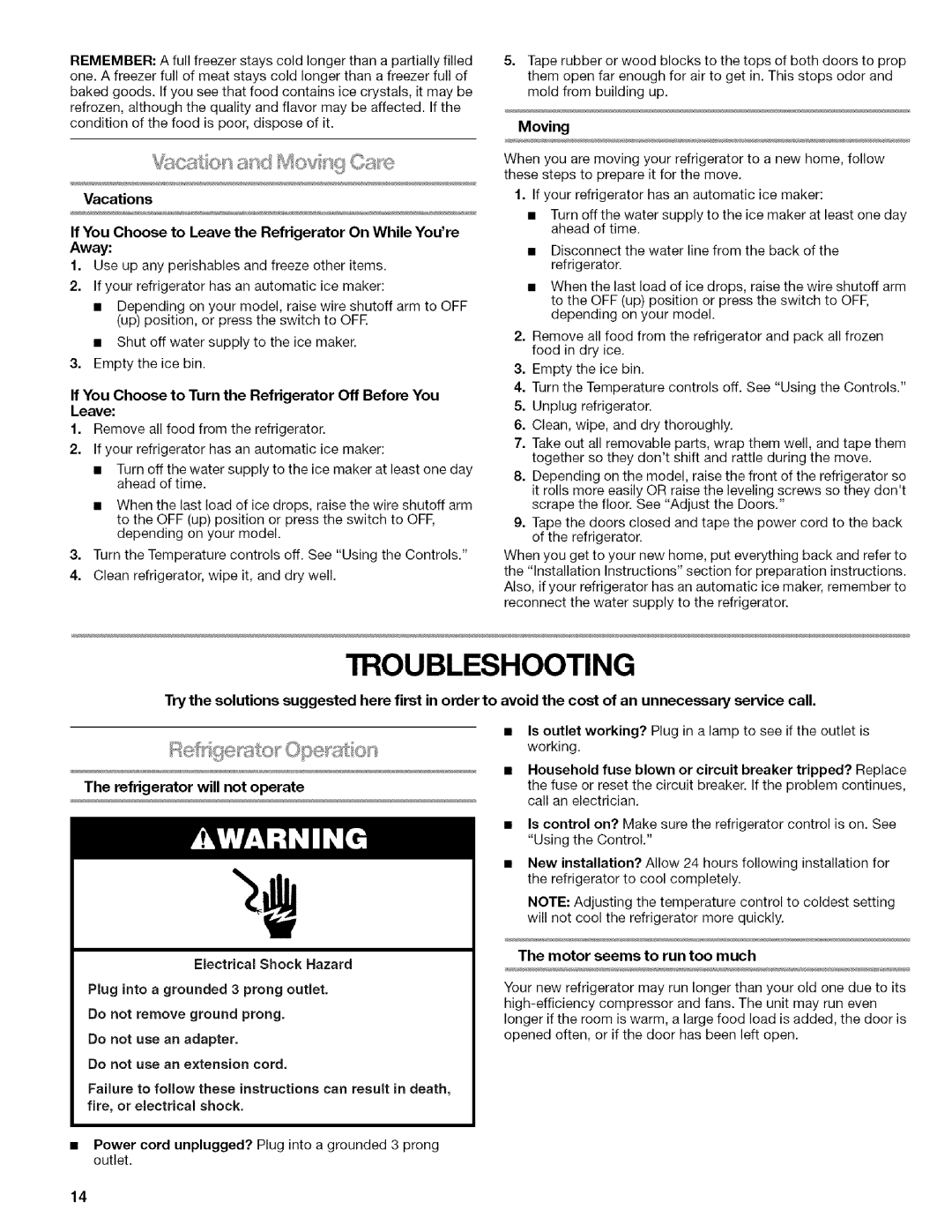
REMEMBER: A full freezer stays cold longer than a partially filled one. A freezer full of meat stays cold longer than a freezer full of baked goods. If you see that food contains ice crystals, it may be refrozen, although the quality and flavor may be affected. If the condition of the food is poor, dispose of it.
Vacations
If You Choose to Leave the Refrigerator On While You're Away:
1.Use up any perishables and freeze other items.
2.If your refrigerator has an automatic ice maker:
•Depending on your model, raise wire shutoff arm to OFF (up) position, or press the switch to OFR
•Shut off water supply to the ice maker.
3.Empty the ice bin.
If You Choose to Turn the Refrigerator Off Before You
Leave:
1.Remove all food from the refrigerator.
2.If your refrigerator has an automatic ice maker:
•Turn off the water supply to the ice maker at least one day ahead of time.
•When the last load of ice drops, raise the wire shutoff arm to the OFF (up) position or press the switch to OFF, depending on your model.
3.Turn the Temperature controls off. See "Using the Controls."
4.Clean refrigerator, wipe it, and dry well.
5.Tape rubber or wood blocks to the tops of both doors to prop them open far enough for air to get in. This stops odor and mold from building up.
Moving
When you are moving your refrigerator to a new home, follow these steps to prepare it for the move.
1.If your refrigerator has an automatic ice maker:
•Turn off the water supply to the ice maker at least one day ahead of time.
•Disconnect the water line from the back of the refrigerator.
•When the last load of ice drops, raise the wire shutoff arm to the OFF (up) position or press the switch to OFF, depending on your model.
2.Remove all food from the refrigerator and pack all frozen food in dry ice.
3.Empty the ice bin.
4.Turn the Temperature controls off. See "Using the Controls."
5.Unplug refrigerator.
6.Clean, wipe, and dry thoroughly.
7.Take out all removable parts, wrap them well, and tape them together so they don't shift and rattle during the move.
8.Depending on the model, raise the front of the refrigerator so it rolls more easily OR raise the leveling screws so they don't scrape the floor. See "Adjust the Doors."
9.Tape the doors closed and tape the power cord to the back of the refrigerator.
When you get to your new home, put everything back and refer to the "Installation Instructions" section for preparation instructions. Also, if your refrigerator has an automatic ice maker, remember to reconnect the water supply to the refrigerator.
TROUBLESHOOTING
Try the solutions suggested here first in order to avoid the cost of an unnecessary service call.
• | Is outlet | working? | Plug | in a lamp | to see if the outlet | is | ||
| working. |
|
|
|
|
|
|
|
• | Household | fuse | blown | or circuit | breaker tripped? | Replace | ||
The refrigerator will not operate | the fuse | or reset the circuit breaker. If the problem | continues, | |||||
| call an electrician. |
|
|
|
|
| ||
• | Is control |
| on? Make sure the refrigerator control | is on. See | ||||
| "Using the | Control." |
|
|
|
| ||
Electrical Shock Hazard
Plug into a grounded 3 prong outlet.
Do not remove ground prong.
Do not use an adapter.
Do not use an extension cord,
Failure to follow these instructions can result in death, fire, or electrical shock.
•Power cord unplugged? Plug into a grounded 3 prong outlet.
•New installation? Allow 24 hours following installation for the refrigerator to cool completely.
NOTE: Adjusting the temperature control to coldest setting will net cool the refrigerator more quickly.
The motor seems to run too much
Your new refrigerator may run longer than your old one due to its
14
